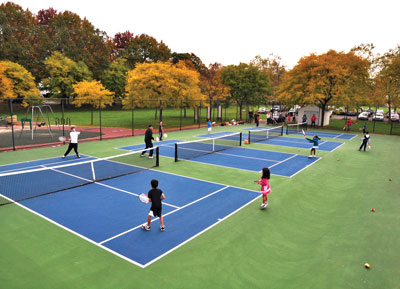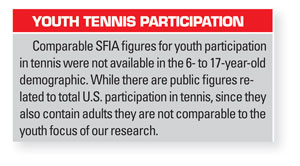Kurt Kamperman, the U.S. Tennis Association’s chief executive for community tennis, has spent the last seven years trying to, in his words, “crack the code” on making tennis appealing, exciting, energizing and life-changing for the youngest among us.
Starting in 2008, Kamperman said, the USTA recognized that, to kids anyway, tennis was stagnant.
Some advances and improvements such as electronic line-calling and the addition of the tiebreak were notable tweaks but, Kamperman said, “The rules of play haven’t changed. So we began to make changes that might make the game more interesting.”
 |
Smaller courts with slower-bouncing balls have made the sport simpler for children.
Photo by: USTA |
In the past five years, the USTA has introduced cost-effective ways to provide smaller courts with slower surfaces that produce slower-bouncing balls. And those tennis balls? They’ve changed colors — red and orange and green — with each color representing a different level of bounce.
Changing the court, changing the balls, those were good first steps, Kamperman said, but further study indicated that the junior tennis model of playing age group tennis, of fighting to earn ranking points, of having children pursuing a solitary course that involved only a parent and a coach, wasn’t working.
“What we were seeing is the idea of spontaneous play disappeared and the kids didn’t like that. They weren’t necessarily excited to see their name in the paper,” he said. “They wanted to play lots of matches. The idea of losing and being eliminated wasn’t so attractive.”
“Kids have so many more options today,” said Sue Hunt, the USTA’s chief marketing officer. “Computers, iPads, gaming. If our sport isn’t fun, we lose kids. And kids are driving more and more decisions.”
Hunt said the USTA has relied on a study called Project Play to tune in to what kids like to do.
Project Play, conceived by the Aspen Institute, is a wide-ranging study conducted to find out what would draw children to sports. One of the things Hunt noticed immediately was that when asked what they most enjoyed about a sports activity, winning was only No. 48 on the list, well behind top responses such as getting playing time, getting along with teammates, and trying your best.
What Project Play also told Kamperman and Hunt was that this age of specialization wasn’t helping individual
sports such as tennis and golf.
Kids, Kamperman said, don’t want their sport to be a job. Kids also like playing with other kids on a team. A life of hitting tennis balls only with a coach isn’t so fun. Kids like company. Kids like teams.
“Tennis seems an individual sport but it can be a great team sport,” he said. “Swimming, for example, is a great lifetime sport that is individual, but put kids on a swim team and they’re more likely to stay with it.”
Billie Jean King has the right idea with her World TeamTennis concept, Hunt said. But more than anything, what the USTA has decided? Staying in place doesn’t work if growing a game is important.
Diane Pucin is a writer in Los Angeles.





